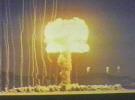
The vertical smoke trails on the left are from small rockets launched just before
detonation to help scientists understand how the shockwave propagates.

Ultra-Fast Nuclear Detonation Pictures 10-nanosecond long images taken 1 millisecond after various nuclear explosions

The vertical
smoke trails on the left are from small rockets launched just before
detonation to
help scientists understand how the shockwave propagates.
While the image above is the stereotypical picture of a nuclear explosion, in reality by the time the classic mushroom cloud has formed all the interesting detail is long over. The following images, borrowed from several sources, show the eerie and complex patterns atomic detonations create immediately after they are triggered. Most of the following images were taken using Rapatronic cameras, ultra-high speed, single-frame cameras developed in the 1940s by Dr. Harold Edgerton. The duration of the exposure is typically 10 nanoseconds (0.00000001 of a second. That's so short that light, which can travel a distance equal to 7 times around the earth in 1 second, would only cover 9.8 feet.)

This image captures two common elements: the spikes (called "rope tricks") and an uneven surface shape.
At this stage of the detonation the surface of the fireball has a temperature of 20,000 degrees, three times hotter than the sun's surface. At such temperatures the amount of thermal radiation (light) given off is so enormous anything it touches is vaporized ahead of the expanding fireball. The three spikes in this image result from the guide wires supporting the tower on which the bomb was located absorbing enough heat to turn into light emitting plasma. Because thermal radiation travels faster than the fireball, the spikes extend out ahead of it.
Experiments with different support wires showed that if they were painted black to better absorb radiation they were longer. If painted with a reflective silver paint they don't appear at all.
One might expect an explosive fireball to expand in a perfect sphere. Actually, variations in the density of the bomb's surrounding case create the mottlings and and complex shapes in many of these images.
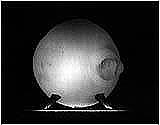

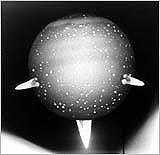
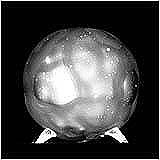


The support tower in the image above provides a convenient size scale. Most of the above images capture the fireball when it is 100 feet in diameter, typically 0.001 seconds after the control operator pressed the "fire" button.


The image above was taken 25 milliseconds later than the others and shows the fireball expanded to 300 feet in diameter, the size of a football field. Instead of a sphere, the fireball has become large enough so that its bottom is in contact with the earth. The even, light grey ring near the bottom of the smooth fireball (more properly called a firedome in this case) is the convolution of the shock wave from the fireball and the reflection of that shock wave from the surface of the earth. This doubly-enhanced shock wave is the area of maximum destructive force, as shown by the expanding ring of rubble below it. For any given bomb size, there is an optimum altitude at which to detonate it to make use of this reflected shock effect to maximize damage.
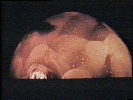
The previous images were of smaller nuclear devices measured in tens to hundreds of kilotons. The one immediately above was taken of the Ivy MIKE device with a rating of 10.7 megatons.

The typical mushroom cloud forms when the fireball occurs near to the earth, then rises pulling a smoke cloud in its wake. In high aerial blasts, like this final image, the detonation altitude is high enough that there is a break between the "cap" of the mushroom and the earth.
Additional Trivia:
The surface of the fireball initially expands outward at a rate of tens of thousands of meters per second.
During the early years of nuclear research, the main effort was in creating larger and more powerful bombs, many of which were rated at several tens of megatons. However, military experts quickly discovered that since the energy from a detonation expands in a sphere, much of the energy is wasted at high altitudes. The optimum size, in terms of the most destructive power from the smallest amount of fissionable material, comes from bombs in the 100-kilotons class.
The average US bomb measures 250 kilotons.
The average Russian bomb measures 400 kilotons
In comparison, the bomb dropped on Hiroshima was 15 kilotons and the one dropped on Nagasaki was 21 kilotons.
A nuclear detonation occurs when enough fissionable material (called the critical mass) is brought together quickly enough to cause a runaway chain reaction. For uranium 235 this is around 22 pounds.
Nuclear fuel is unbelievably energy dense. The volume of plutonium used in the Nagasaki bomb was the size of a softball. Even more amazing is that the 21 kiloton yield reflects a very inefficient use (a few percent) of the total energy potential of the plutonium.
Nuclear explosions are possible from smaller amounts of fissionable material by using the extremely high pressure of a surrounding chemical explosion to compress fissionable material to such a high density that a runaway chain reaction can be sustained.
Nuclear detonations all experience a characteristic "double flash." Early in the detonation the explosion consists of two concentric spheres. The outer one is created by a sudden flood of radiation being absorbed by the surrounding air and heating it to incandescence. The inner one is the fireball of the vaporized solid elements of the bomb itself. The ionized structure of the outer shell makes it opaque to light from the inner shell so all that can be seen is the light the outer shell gives off. A millisecond or so after the detonation, the inner shell expands far enough that it blows through the outer shell and the glowing surface of the now exposed inner fireball can be seen, hence the second flash.
The largest nuclear weapon ever exploded was Russia's "super-bomb," rated at 57 megatons. Detonated in 1961, it was largely for political purposes because at the time the Soviet Union had no airplane or missile that could carry the 27 ton bomb over any great distance.
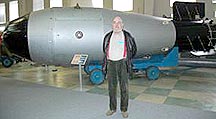
Officially designated RDS-220, it was called "Ivan" or "Big Ivan" in Russia (Tsar Bomba in the West), the bomb was much larger than indicated in the above picture. The man is standing twenty feet in front of it making him look larger and the weapon smaller.
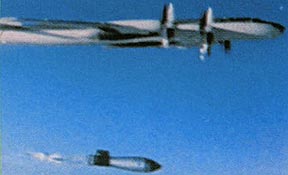
It was dropped for its one and only test from a specially modified Tu-95n (Bear) strategic bomber. Slowed by parachute, it detonated at an altitude of 13,000 feet 188 seconds after release.
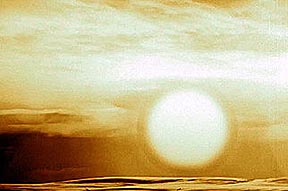
The fireball could be seen 900 miles away and had a diameter estimated at over 5 miles.

The resulting mushroom cloud reached an altitude of 210,000 feet. The shock wave from the blast broke windows 800 miles away. The bomb was originally designed for a 100 megaton yield, but down sized to reduce radioactive contamination. The following image may help provide a sense of scale for the enormous power of this detonation:

The Hiroshima and Nagasaki bombs barely show up at this scale, and together they killed over 200,000 people. The average US and Russian bombs are tiny smudges. Even the mega-bombs exploded by the United States are dwarfed by Ivan. If the full sized version had been detonated over the city of Ontario in Southern California the zone of total destruction would have been 100 miles in diameter, as indicated by the yellow circle in the following image:

Los Angeles and all of it's surrounding cities would have been wiped from the face of the earth, killing fifteen million people in the blink of an eye.
The
problem with getting a nuclear bomb to explode is bringing the
fissionable materials together fast enough. Done too slowly they melt
and vaporize before the runaway chain reaction can take place. The
required rapid combination is usually achieved by surrounding the
core segments with chemical explosives. While these explosives create
the speed of combination required, they also create another problem:
uneven detonation. To get a sphere of explosives to detonate all at
once many detonators have to be used. These have to be timed to all
go off at exactly the same time. Doing so requires numerous problems
such as variations in detonator reaction time, delays caused by
detonator cable lengths, uneven local explosion forces caused by
minor variations in the explosive and a host of other issues to be
solved. Think of trying to wrap jello with rubber bands and you get a
feel for the problem. In theory it's possible, but doing it in the
real world is a challenge. Making an atomic bomb is not the simple
task it's made out to be in television thrillers.
I hope you have found this page interesting. It was not intended to defend nuclear weapons, nor argue against them. It's just to provide a little information about them.
(Click
on main site
to browse 70 other topics ranging from exotic kaleidoscope designs to
the strange world of lucid dreaming.)